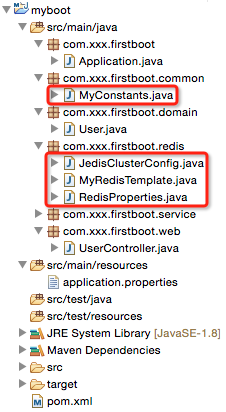【第三章】 springboot + jedisCluster
如果使用的是redis2.x,在项目中使用客户端分片(Shard)机制。(具体使用方式:第九章 企业项目开发--分布式缓存Redis(1) 第十章 企业项目开发--分布式缓存Redis(2))
如果使用的是redis3.x中的集群,在项目中使用jedisCluster。
redis3.2.5集群搭建:第十二章 redis-cluster搭建(redis-3.2.5)
1、项目结构

2、pom.xml
<?xml version="1.0" encoding="UTF-8"?>
<project xmlns="http://maven.apache.org/POM/4.0.0" xmlns:xsi="http://www.w3.org/2001/XMLSchema-instance"
xsi:schemaLocation="http://maven.apache.org/POM/4.0.0 http://maven.apache.org/maven-v4_0_0.xsd">
<modelVersion>4.0.0</modelVersion>
<groupId>com.xxx</groupId>
<artifactId>myboot</artifactId>
<version>1.0-SNAPSHOT</version>
<properties>
<java.version>1.8</java.version><!-- 官方推荐 -->
</properties>
<!-- 引入spring-boot-starter-parent做parent是最好的方式,
但是有时我们可能要引入我们自己的parent,此时解决方式有两种:
1)我们自己的parent的pom.xml的parent设为spring-boot-starter-parent(没有做过验证,但是感觉可行)
2)使用springboot文档中的方式:见spring-boot-1.2.5-reference.pdf的第13页
-->
<parent>
<groupId>org.springframework.boot</groupId>
<artifactId>spring-boot-starter-parent</artifactId>
<version>1.2.5.RELEASE</version>
</parent>
<!-- <dependencyManagement>
<dependencies>
<dependency>
Import dependency management from Spring Boot
<groupId>org.springframework.boot</groupId>
<artifactId>spring-boot-dependencies</artifactId>
<version>1.2.5.RELEASE</version>
<type>pom</type>
<scope>import</scope>
</dependency>
</dependencies>
</dependencyManagement> -->
<!-- 引入实际依赖 -->
<dependencies>
<dependency>
<groupId>org.springframework.boot</groupId>
<artifactId>spring-boot-starter-web</artifactId>
</dependency>
<dependency>
<groupId>redis.clients</groupId>
<artifactId>jedis</artifactId>
</dependency>
<dependency>
<groupId>com.alibaba</groupId>
<artifactId>fastjson</artifactId>
<version>1.1.15</version>
</dependency>
<dependency>
<groupId>org.apache.commons</groupId>
<artifactId>commons-lang3</artifactId>
<version>3.3.2</version>
</dependency>
</dependencies>
<build>
<plugins>
<!-- 用于将应用打成可直接运行的jar(该jar就是用于生产环境中的jar) 值得注意的是,如果没有引用spring-boot-starter-parent做parent,
且采用了上述的第二种方式,这里也要做出相应的改动 -->
<plugin>
<groupId>org.springframework.boot</groupId>
<artifactId>spring-boot-maven-plugin</artifactId>
</plugin>
</plugins>
</build>
</project>
说明:相对于上一章的代码仅仅引入了jedis的依赖jar。
3、application.properties
#user info user.id=1 user.username=zhaojigang user.password=123 #redis cluster redis.cache.clusterNodes=localhost:8080 redis.cache.commandTimeout=5 #unit:second redis.cache.expireSeconds=120
说明:相对于上一章的代码仅仅引入了redis cluster的配置信息
4、Application.java(springboot启动类,与上一章一样)
5、RedisProperties.java(Redis属性装配)
package com.xxx.firstboot.redis;
import org.springframework.boot.context.properties.ConfigurationProperties;
import org.springframework.stereotype.Component;
@Component
@ConfigurationProperties(prefix = "redis.cache")
public class RedisProperties {
private int expireSeconds;
private String clusterNodes;
private int commandTimeout;
public int getExpireSeconds() {
return expireSeconds;
}
public void setExpireSeconds(int expireSeconds) {
this.expireSeconds = expireSeconds;
}
public String getClusterNodes() {
return clusterNodes;
}
public void setClusterNodes(String clusterNodes) {
this.clusterNodes = clusterNodes;
}
public int getCommandTimeout() {
return commandTimeout;
}
public void setCommandTimeout(int commandTimeout) {
this.commandTimeout = commandTimeout;
}
}
说明:与上一章的User类似,采用@ConfigurationProperties注解自动读取application.properties文件的内容并装配到RedisProperties的每一个属性中去。
6、JedisClusterConfig.java(获取JedisCluster单例)
package com.xxx.firstboot.redis;
import java.util.HashSet;
import java.util.Set;
import org.springframework.beans.factory.annotation.Autowired;
import org.springframework.context.annotation.Bean;
import org.springframework.context.annotation.Configuration;
import redis.clients.jedis.HostAndPort;
import redis.clients.jedis.JedisCluster;
@Configuration
public class JedisClusterConfig {
@Autowired
private RedisProperties redisProperties;
/**
* 注意:
* 这里返回的JedisCluster是单例的,并且可以直接注入到其他类中去使用
* @return
*/
@Bean
public JedisCluster getJedisCluster() {
String[] serverArray = redisProperties.getClusterNodes().split(",");//获取服务器数组(这里要相信自己的输入,所以没有考虑空指针问题)
Set<HostAndPort> nodes = new HashSet<>();
for (String ipPort : serverArray) {
String[] ipPortPair = ipPort.split(":");
nodes.add(new HostAndPort(ipPortPair[0].trim(), Integer.valueOf(ipPortPair[1].trim())));
}
return new JedisCluster(nodes, redisProperties.getCommandTimeout());
}
}
说明:
- 该类注入了RedisProperties类,可以直接读取其属性
- 这里没有对jedis链接池提供更多的配置(jedis-2.5.x好像不支持,jedis-2.6.x支持),具体的配置属性可以查看文章开头第一篇博客
注意:
- 该类使用了Java注解,@Configuration与@Bean,
- 在方法上使用@Bean注解可以让方法的返回值为单例,
- 该方法的返回值可以直接注入到其他类中去使用
- @Bean注解是方法级别的
- 如果使用的是常用的spring注解@Component,
- 在方法上没有注解的话,方法的返回值就会是一个多例,
- 该方法的返回值不可以直接注入到其他类去使用
- 该方式的注解是类级别的
7、MyRedisTemplate.java(具体redis操作)
package com.xxx.firstboot.redis;
import org.slf4j.Logger;
import org.slf4j.LoggerFactory;
import org.springframework.beans.factory.annotation.Autowired;
import org.springframework.stereotype.Component;
import redis.clients.jedis.JedisCluster;
@Component
public class MyRedisTemplate {
private static final Logger LOGGER = LoggerFactory.getLogger(MyRedisTemplate.class);
@Autowired
private JedisCluster jedisCluster;
@Autowired
private RedisProperties redisProperties;
private static final String KEY_SPLIT = ":"; //用于隔开缓存前缀与缓存键值
/**
* 设置缓存
* @param prefix 缓存前缀(用于区分缓存,防止缓存键值重复)
* @param key 缓存key
* @param value 缓存value
*/
public void set(String prefix, String key, String value) {
jedisCluster.set(prefix + KEY_SPLIT + key, value);
LOGGER.debug("RedisUtil:set cache key={},value={}", prefix + KEY_SPLIT + key, value);
}
/**
* 设置缓存,并且自己指定过期时间
* @param prefix
* @param key
* @param value
* @param expireTime 过期时间
*/
public void setWithExpireTime(String prefix, String key, String value, int expireTime) {
jedisCluster.setex(prefix + KEY_SPLIT + key, expireTime, value);
LOGGER.debug("RedisUtil:setWithExpireTime cache key={},value={},expireTime={}", prefix + KEY_SPLIT + key, value,
expireTime);
}
/**
* 设置缓存,并且由配置文件指定过期时间
* @param prefix
* @param key
* @param value
*/
public void setWithExpireTime(String prefix, String key, String value) {
int EXPIRE_SECONDS = redisProperties.getExpireSeconds();
jedisCluster.setex(prefix + KEY_SPLIT + key, EXPIRE_SECONDS, value);
LOGGER.debug("RedisUtil:setWithExpireTime cache key={},value={},expireTime={}", prefix + KEY_SPLIT + key, value,
EXPIRE_SECONDS);
}
/**
* 获取指定key的缓存
* @param prefix
* @param key
*/
public String get(String prefix, String key) {
String value = jedisCluster.get(prefix + KEY_SPLIT + key);
LOGGER.debug("RedisUtil:get cache key={},value={}", prefix + KEY_SPLIT + key, value);
return value;
}
/**
* 删除指定key的缓存
* @param prefix
* @param key
*/
public void deleteWithPrefix(String prefix, String key) {
jedisCluster.del(prefix + KEY_SPLIT + key);
LOGGER.debug("RedisUtil:delete cache key={}", prefix + KEY_SPLIT + key);
}
public void delete(String key) {
jedisCluster.del(key);
LOGGER.debug("RedisUtil:delete cache key={}", key);
}
}
注意:
这里只是使用了jedisCluster做了一些字符串的操作,对于list/set/sorted set/hash的操作,可以参考开头的两篇博客。
8、MyConstants.java(缓存前缀常量定义类)
package com.xxx.firstboot.common;
/**
* 定义一些常量
*/
public class MyConstants {
public static final String USER_FORWARD_CACHE_PREFIX = "myboot:user";// user缓存前缀
}
注意:
- 根据业务特点定义redis的缓存前缀,有助于防止缓存重复导致的缓存覆盖问题
- 缓存前缀使用":"做分隔符,这是推荐做法(这个做法可以在使用redis-desktop-manager的过程看出来)
9、UserController.java(测试)
package com.xxx.firstboot.web;
import org.apache.commons.lang3.StringUtils;
import org.springframework.beans.factory.annotation.Autowired;
import org.springframework.web.bind.annotation.RequestMapping;
import org.springframework.web.bind.annotation.RequestParam;
import org.springframework.web.bind.annotation.RestController;
import com.alibaba.fastjson.JSON;
import com.xxx.firstboot.common.MyConstants;
import com.xxx.firstboot.domain.User;
import com.xxx.firstboot.redis.MyRedisTemplate;
import com.xxx.firstboot.service.UserService;
/**
* @RestController:spring mvc的注解,
* 相当于@Controller与@ResponseBody的合体,可以直接返回json
*/
@RestController
@RequestMapping("/user")
public class UserController {
@Autowired
private UserService userService;
@Autowired
private MyRedisTemplate myRedisTemplate;
@RequestMapping("/getUser")
public User getUser() {
return userService.getUser();
}
@RequestMapping("/testJedisCluster")
public User testJedisCluster(@RequestParam("username") String username){
String value = myRedisTemplate.get(MyConstants.USER_FORWARD_CACHE_PREFIX, username);
if(StringUtils.isBlank(value)){
myRedisTemplate.set(MyConstants.USER_FORWARD_CACHE_PREFIX, username, JSON.toJSONString(getUser()));
return null;
}
return JSON.parseObject(value, User.class);
}
}
说明:相对于上一章,只是添加了测试缓存的方法testJedisCluster。
测试:
在Application.properties右击-->run as-->java application,在浏览器输入"localhost:8080/user/testJedisCluster?username=xxx"即可。
附:对于redis的测试,我们有时需要查看执行set后,缓存是否存入redis的db中了,有两种方式
- 执行set后,get数据,之后修改数据,在get数据,比较两次get的数据是否相同即可
- 有时,这些数据是无法修改的(假设该数据是我们从第三方接口得来的),这个时候可以使用redis-desktop-manager这个软件来查看缓存是否存入redis(该软件的使用比较简单,查看官网)
【第三章】 springboot + jedisCluster的更多相关文章
- 第三章 springboot + jedisCluster(转载)
本编博客转发自:http://www.cnblogs.com/java-zhao/p/5347703.html 如果使用的是redis2.x,在项目中使用客户端分片(Shard)机制. 如果使用的是r ...
- 第三章 springboot + jedisCluster
如果使用的是redis2.x,在项目中使用客户端分片(Shard)机制.(具体使用方式:第九章 企业项目开发--分布式缓存Redis(1) 第十章 企业项目开发--分布式缓存Redis(2)) 如果 ...
- 第二十五章 springboot + hystrixdashboard
注意: hystrix基本使用:第十九章 springboot + hystrix(1) hystrix计数原理:附6 hystrix metrics and monitor 一.hystrixdas ...
- spring boot 笔记--第三章
spring boot 笔记 第三章,使用Spring boot 构建系统: 强烈建议支持依赖管理的构建系统,Maven或Gradle 依赖管理: Spring Boot的每版本都会提供它支持的依赖列 ...
- 《精通Spring4.x企业应用开发实战》第三章
这一章节主要介绍SpringBoot的使用,也是学习的重点内容,之后就打算用SpringBoot来写后台,所以提前看一下还是很有必要的. 3.SpringBoot概况 3.1.1SpringBoot发 ...
- 《Django By Example》第三章 中文 翻译 (个人学习,渣翻)
书籍出处:https://www.packtpub.com/web-development/django-example 原作者:Antonio Melé (译者注:第三章滚烫出炉,大家请不要吐槽文中 ...
- 《Linux内核设计与实现》读书笔记 第三章 进程管理
第三章进程管理 进程是Unix操作系统抽象概念中最基本的一种.我们拥有操作系统就是为了运行用户程序,因此,进程管理就是所有操作系统的心脏所在. 3.1进程 概念: 进程:处于执行期的程序.但不仅局限于 ...
- Python黑帽编程3.0 第三章 网络接口层攻击基础知识
3.0 第三章 网络接口层攻击基础知识 首先还是要提醒各位同学,在学习本章之前,请认真的学习TCP/IP体系结构的相关知识,本系列教程在这方面只会浅尝辄止. 本节简单概述下OSI七层模型和TCP/IP ...
- 《Entity Framework 6 Recipes》中文翻译系列 (11) -----第三章 查询之异步查询
翻译的初衷以及为什么选择<Entity Framework 6 Recipes>来学习,请看本系列开篇 第三章 查询 前一章,我们展示了常见数据库场景的建模方式,本章将向你展示如何查询实体 ...
- 《Entity Framework 6 Recipes》中文翻译系列 (19) -----第三章 查询之使用位操作和多属性连接(join)
翻译的初衷以及为什么选择<Entity Framework 6 Recipes>来学习,请看本系列开篇 3-16 过滤中使用位操作 问题 你想在查询的过滤条件中使用位操作. 解决方案 假 ...
随机推荐
- wordpress如何正确自动获取中文日志摘要
WordPress 函数 get_the_excerpt() 可以获取日志的摘要,如果没有摘要,它会自动获取内容,并且截取.但是由于无法正确统计中文字符数,我爱水煮鱼撰写了下面这个函数来解决这个问题. ...
- Dom最常用的API
document方法: getElementById(id) Node 返回指定结点的引用 getElementsByTagName(name) NodeList 返回文档中所有匹配的元素的集合 cr ...
- SQL Server 安装后改动计算机名带来的问题以及解决方法
USE master GO DECLARE @serverproperty_servername varchar(100), @servername varchar(100) --取得Windows ...
- IO操作文件的复制与删除
import java.io.File;import java.io.FileInputStream;import java.io.FileOutputStream;import java.io.IO ...
- mybatis中使用where in查询时的注意事项
我使用的时候collection值为mapper的参数名如:int deleteRoleByUserIds(@Param("userIds") String[] userIds); ...
- POJ:2049Finding Nemo(bfs+优先队列)
http://poj.org/problem?id=2049 Description Nemo is a naughty boy. One day he went into the deep sea ...
- col-md-1
.col-md-12 { width: 100%; } .col-md-11 { width: 91.66666666666666%; } .col-md-10 { widt ...
- 机器学习理论基础学习12---MCMC
作为一种随机采样方法,马尔科夫链蒙特卡罗(Markov Chain Monte Carlo,以下简称MCMC)在机器学习,深度学习以及自然语言处理等领域都有广泛的应用,是很多复杂算法求解的基础.比如分 ...
- jmeter 逻辑控制器Logic Controller详解
Jmeter之逻辑控制器(Logic Controller) 前言: 1. Jmeter官网对逻辑控制器的解释是:“Logic Controllers determine the order in w ...
- 用户用户组管理:用户管理命令-passwd
passwd直接回车就是给root设密码.或加root. 普通用户只能改自己的密码.改时直接敲passwd,回车.否则报错. 因为只有root可以在passwd后加用户名.其实最常见的就是不加选项. ...
